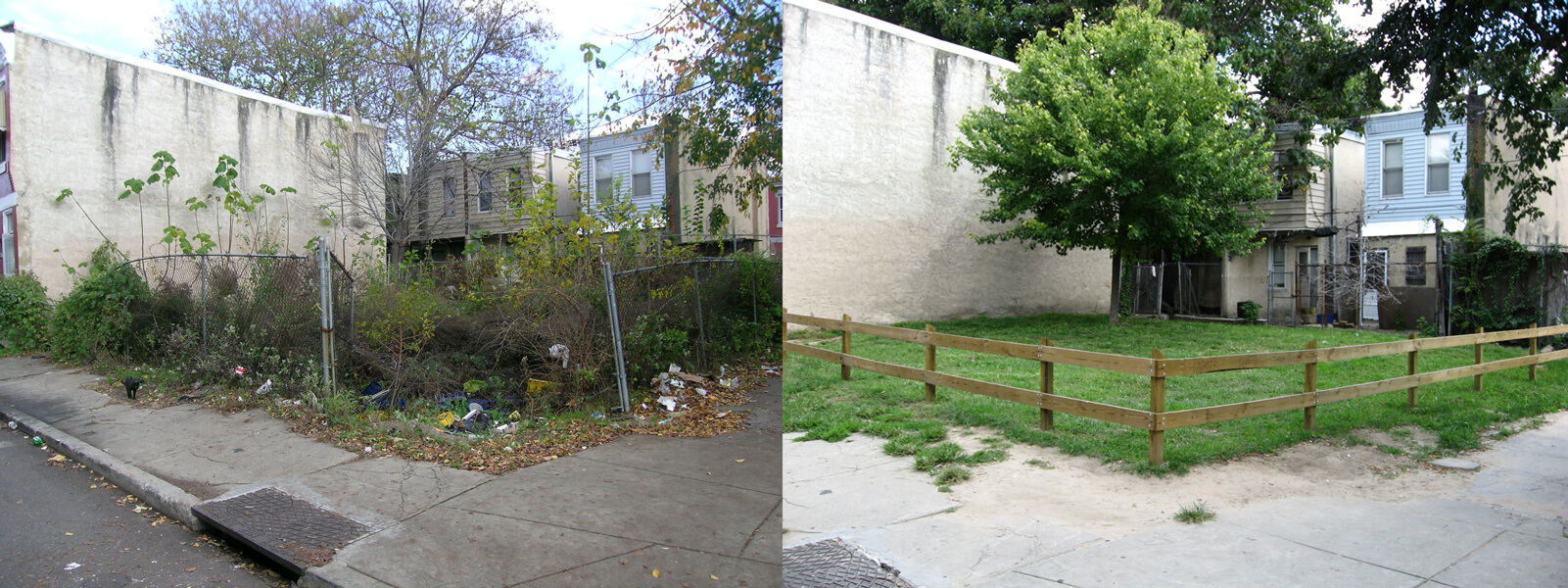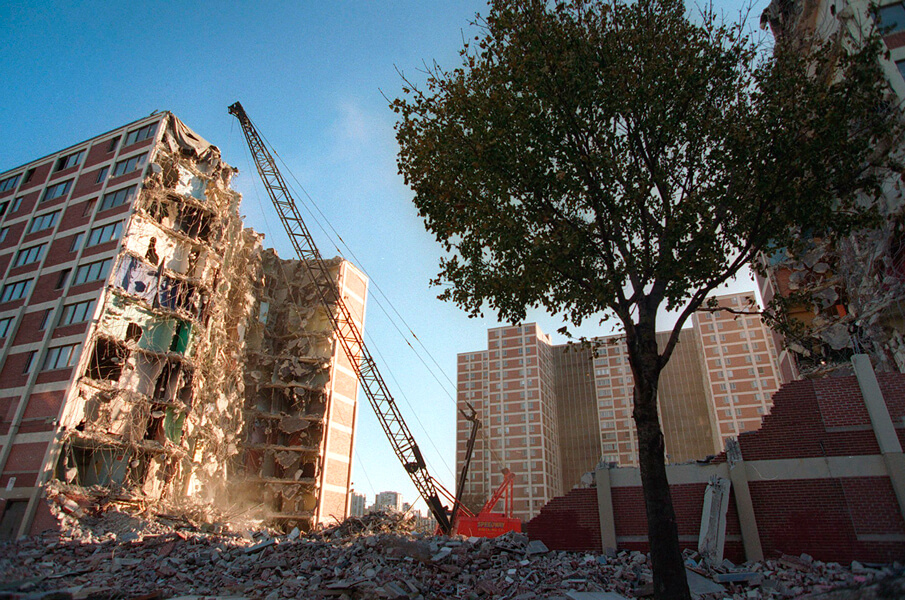Violence dramatically affects the people directly involved — but it doesn’t stop there: The repercussions, especially of gun violence, ripple out across entire communities.
People become frightened, stressed and less engaged in neighborhood life. Their physical and mental health suffer. Those who are financially better off move away, and housing prices decline, setting in motion a downward community spiral — one that engenders still more violence.
“Violence is not just these little isolated instances of one individual doing a bad thing to another person,” says Michelle Kondo, a social scientist at the US Forest Service Northern Research Station in Philadelphia. “Crimes happen in a context, and environments can contribute to those acts of violence.”
Kondo is one of a growing number of sociologists, epidemiologists and public health researchers who are focusing on neighborhoods as the most effective context in which to study violence and devise innovative interventions. They say that how communities are arranged — and the subtle cues people encounter as they move about in them — affects the way they live and interact with others. This makes a place either vibrant and welcoming, or the opposite.
“Some places are more violent than others,” says Robert Sampson, a social scientist at Harvard University who studies crime and urban inequality. This, he adds, “suggests that the locus of intervention should be the neighborhood. That’s not to say that individuals are not important — it does say that you can get a lot more crime-reduction effect from a more population-based approach.”
Neighborhood-level interventions may not only cut down violence and crime but benefit communities in other ways, too. “These small — what we call ‘treatments,’ because of a public health perspective — have big effects on neighborhood life,” says Bernadette Hohl, an epidemiologist at Rutgers University. She says that residents are quick to realize that the interventions also improve community well-being, social interactions and civility between neighbors. They improve the health of people who live in such communities, replacing chronic fear and poor coping responses such as drug use with reduced stress and risk of mental illness.
Many studies that examine ways to reduce crime through changing the look and feel of neighborhoods are limited because they're not able to compare the findings to untreated “control” regions. However, a series of studies examining the effects of urban blight reduction in Philadelphia included such controls — and reported encouraging effects on rates of violent and other crimes.
The most promising interventions to emerge so far from this public health approach are improved housing and blight remediation. Spreading out public housing — replacing high-rises with dispersed, scattered-site buildings — has been shown to effectively reduce violent crime. Improving, or “treating,” abandoned buildings and vacant lots can also reduce rates of violence and improve public health, at relatively low cost and with little political resistance.
Building safer, healthier neighborhoods
Disintegrating buildings with boarded-up doors and smashed windows alongside plots full of weeds and trash are much more common than one might think. About 15 percent of the land in US cities is considered vacant or abandoned — a swath that adds up to roughly the size of Switzerland.
Kondo and her colleagues have focused their research on blight remediation in the abandoned buildings and vacant lots of Philadelphia, which has more than 3,000 deserted properties. In research they published in 2018, they reported that residents living near “treated” vacant lots, where trash and debris had been removed and people planted grass and trees, felt the neighborhoods had markedly improved, according to interviews with 445 randomly selected people in the area.

Cleaning up urban blight such as this vacant lot — shown before and after — may help to reduce crime rates.
CREDIT: COURTESY CHARLES BRANAS
Police reports also showed as much as a 29 percent reduction in gun violence, which, if scaled up to the whole city, would translate to 350 fewer shootings each year. Interviewees’ perceptions of crime and safety concerns when going outside the home were reduced by 37 percent and 58 percent, respectively. A follow-up study published this year surveyed 342 Philadelphians living near such vacant lots and found that their feelings of depression and poor mental health dropped by about half.
Charles Branas, an epidemiologist at Columbia University, collaborated with Kondo on the Philadelphia research on remediating dilapidated buildings and vacant urban land. To explain their results, he invokes a kind of “broken windows theory”: Neglected and vandalized spaces start to multiply because people are fearful and are less apt to maintain the upkeep of an area if it’s surrounded by places that haven’t been kept up. And that allows serious crime to move in.
“But we find that if you go in and clean those places, if you fix the buildings even in a very basic way, and if you green abandoned land, people begin to become invested in that space and they don’t want it to return to the way it was,” Branas says.
The nature of public housing also plays a significant role. More incidences of violence tend to occur in places with concentrated public housing such as tower blocks. But when Chicago demolished 161 old high-rise public housing units in the 1990s, for example, the numbers of gunshots fired, and homicide rates, dropped by 5 percent to 8.5 percent across the city and outweighed small rises in crime in the areas where former tower-block residents moved to.

Demolishing concentrated public housing, such as this Chicago tower block, and replacing it with more dispersed residences helped to reduce violent crime in the city.
CREDIT: AP PHOTO / BETH A. KEISER
Another team of researchers studied Denver over the same period, as the city built 38 dispersed public housing units. Residents in those neighborhoods saw no increase in crime rates, and the study authors suggest that the new structures may have led to lower crime rates in some nearby areas.
The promise of holistic, customizable interventions
Of course, widespread violence is a massive, complex problem, and multipronged solutions would likely work best. Poverty, poor nutrition, guns and environmental contamination — such as high levels of lead exposure — can all play major roles in both public health and levels of chronic violence, and they all should be addressed, these researchers say.
But grasping some of these obvious, large nettles can be very difficult. It’s hard to change the economic system, it’s controversial to enact stronger gun control laws and it’s expensive to rebuild large-scale infrastructure.
That is why proponents of altering neighborhood environments say this approach is so promising: It provides some quick wins. Early reports already have implications for city planners and policy-makers seeking simple, cost-effective interventions to reduce violence, which currently costs the US tens of billions of dollars in work loss and medical bills every year.
Social scientists continue to seek out treatments that could make a dent in crime that hits poor communities the hardest. These might include reducing alcohol availability, opening new neighborhood schools and improving public transit, although findings from studies have been mixed. The gold standard approach toward such studies are randomized controlled trials — like what’s done when testing drug treatments for an ailment, but on a citywide scale. The Philadelphia studies were structured that way (only certain neighborhoods were targeted for treatment) but many other, earlier interventions were not.
Cities may find that reshaping their built environment is a relatively easy, uncontroversial way to tackle the complex problem of violence and improve public health at the same time, Branas says.
“Political opposition to this is nil. The gun lobby’s not opposed to this at all, so this is largely an apolitical treatment for gun violence in our cities,” he says. “Impoverished neighborhoods in cities are desperately in need of inexpensive treatments like this.”




